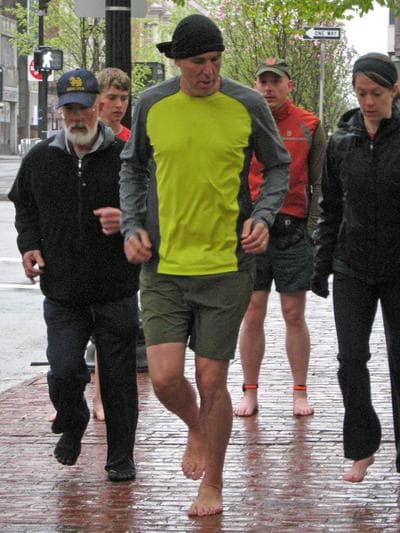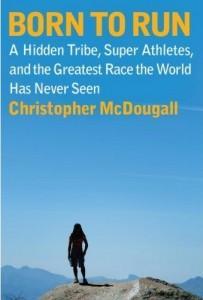Advertisement
Shoeless Craze Sweeps Running Community

The recreational running craze took off in the 1970s with the mantra: "All you need to run is a shirt, shorts and a pair of shoes." But those shoes have become more complicated over the past few decades and modern running shoes cost anywhere from $80 to $200. And so a movement is sweeping through the running community suggesting that shoes might not be needed at all.
Quietly Gaining
Which is how, at 7 a.m. two days before the Boston Marathon, as workers erected barricades along the race route, a small revolution took place inside a Boston sporting goods store. After reading a book called "Born To Run," runners like Alice Jenney, from Houston, slowed by foot and leg injuries, say they’re no longer afraid to run barefoot.

“No, I will do it in a heartbeat,” Jenney says. “Because I’m a runner and that’s what I do.”
For the past year, Christopher McDougall, the book's author, has appeared on talk shows and crisscrossed the country for book signings — usually in his bare feet. On this day, he plopped those feet atop a bench in front of thousands of dollars worth of the best Nike, Adidas and Saucony has to offer, preaching against wearing shoes.
“Asics now has a shoe which is responsive to women’s menstrual cycles,” McDougall tells the crowd. “If you want to sell something, if you want to have the greatest marketing tool of all time, that’s fear.”
McDougall’s fear came from something called Cuboid syndrome. His doctors told him he’s too tall, too broad, and too solid to run. (Picture the guy who played the mummy in those Brendan Fraser movies.) Now, a few pounds lighter, McDougall still looks like he could fit Ethiopian distance runner Haile Gebrselassie in his back pocket, but he says he hasn’t had a single running injury since he stopped wearing traditional running shoes.
Advertisement
McDougall didn’t invent barefoot running. But he brought it to the masses.
“We’ve hit at a critical juncture where so many people have been hurt for so long that they’re desperate,” McDougall says. “They’re obsessed because they want to be able to run around and not get hurt anymore.”
"Born To Run" is the de facto bible for a new generation of barefoot runners. But, on the front cover, ultra-marathoner Billy Barnett stands in silhouette, high atop a mountain in Mexico. And Billy is wearing shoes.
Only a single chapter of the tale of adventure, biology, physics, evolution and ultra-marathon history actually addresses running shoes and why we might not need them. McDougall says he didn’t know those 16 pages would fuel a movement.
“No idea,” McDougall admits. “Matter of fact, I almost cut that chapter about the shoes out of the book because when you start to get immersed in this stuff, after a while you just take for granted that everybody knows this. Because it’s so logical and it makes such perfect sense when you try it yourself.”
But Kevin Kilbride, a marathoner from Santa Monica, Calif., was far from convinced. He was in Boston to run the marathon — and injured — but he wasn't swayed by McDougall’s pitch.
“I picked up the book,” Kilbride says, “and within three pages I knew the bias, I knew where he was going with it. And he’s a damn good writer, and I’ll finish the book, but I really think it’s crap.”
Competing Evidence
Two days later, most marathon runners were wearing shoes. Precious few wore minimalist running shoes or went completely barefoot. Robert Forster, a California physical therapist who’s brought everyone from Jackie Joyner-Kersee to Pete Sampras back from injury, pointed out that none of the winners are without shoes.
 “And I was at the New York Marathon this year. I was at the L.A. Marathon," Forster says. "I saw a handful of barefoot runners, and let me remind my colleagues in barefoot running that none of the elite Kenyans were barefoot in the races I saw. So presumably they switched from barefoot to shoes for a reason.”
“And I was at the New York Marathon this year. I was at the L.A. Marathon," Forster says. "I saw a handful of barefoot runners, and let me remind my colleagues in barefoot running that none of the elite Kenyans were barefoot in the races I saw. So presumably they switched from barefoot to shoes for a reason.”Barefoot running enthusiasts point to runners from Kenya’s Rift Valley and a small tribe in Mexico’s Copper Canyon as proof that people can run successfully for very long distances without shoes. But, Forster says, there’s no reason those successes apply to everyone else.
“They need to remember that those folks have been running barefoot since they were little kids,” Forster says. “I do think your skin will toughen up, but have the joints of your feet, which have been babied by wearing shoes your whole life, are they ready for the forces of barefoot running?”
Forster says even with proper running technique, modern shoes are still needed for the most common running problem, overpronation. In the past 30 years, Forster says he’s seen injuries decrease as running shoes improve.
Dan Lieberman, a Harvard professor of human evolutionary biology, says that’s hogwash.
“Nobody’s ever done a study which shows that your shoes prevent you from getting injured,” Lieberman says. “The flip side of that is nobody’s ever done a study that not wearing shoes prevents you from getting injured either. So right now were operating in an absence of information.”
What Lieberman has been studying for years is how humans, about 2 million years ago, evolved to become the best long distance runners in the mammalian world. Lieberman says we have features, from our heads to our toes, that are designed specifically for running, and some of those features seem to work best when we’re barefoot. Lieberman says barefoot running is less impactful than the typical heel strike most do in shoes, and he says he can prove it.
The Test Case
Lieberman stripped me of my shoes and put me on a treadmill rigged atop a force plate and attached to a computer. Turns out, I’m a perfect test subject.
As the treadmill ramped up to running speed, Lieberman listened to the "thwack, thwack" my feet made every time they hit the ground. He said that noise is an indication of a major impact.
Lieberman showed me a graph of my short run. When my heel hit the ground, about two times my body weight slammed back up my leg in just one tenth of a second. Lieberman compared it to taking a hammer and hitting myself on the heel. No wonder I like my cushy-soled, pronation-correcting running shoes.
A quick lesson in barefoot running technique and I was back on the treadmill. This time, not only was the sound of my feet quieter, but the impact graph looked like a series of smooth rolling hills.
Instead of my foot loading that impact in a tenth of a second, the barefoot running style allowed my body to absorb that energy over time, and the natural spring in my arch helped me bounce back. But, Lieberman cautioned, before I can become a true barefoot runner, I need to build up strength in my feet and my calves. And that needs to be done over time.
"Don’t do more than a mile at first,” he warns. “If you decide to go run five miles tomorrow barefoot you will curse the day you ever tried it. You will be unhappy. You will be in pain. It will not be fun.”
The next day, I strapped on my five-finger shoes and set out on my first barefoot-style run. I like it. Instead of hearing the "slap, slap" of my feet over the music in my iPod, I take the buds out of my ears and enjoy the sounds of the birds in the trees and the geese on the water.
In fact, the only discomfort comes from a blister on my big toe. Maybe next time I go for a run, I’ll put on my pronation-correcting running shoes. Or maybe I’ll go barefoot. Lieberman says the point of the barefoot movement isn’t to tell people what they should or should not put on their feet. The point is to tell us that we have the choice.
This program aired on May 8, 2010. The audio for this program is not available.

